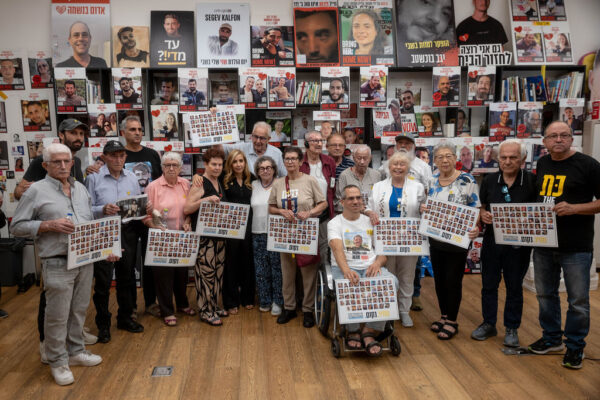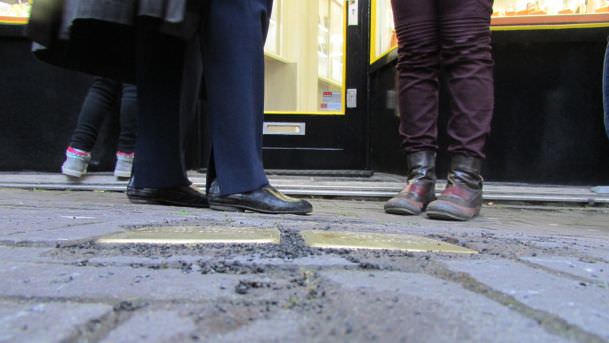
Newly laid tripping stones, commemorating Holocaust victims Salomon van Gelder and Fijtje Fruitman, in Amsterdam. Photo Credit: Steven J. Klein
For us, it was the first time. For him, it was somewhere closer to his 57,000th time.
Artist Gunter Demnig has dedicated his professional career to placing memorial plaques in front of thousands of European homes, from which Jews, Sinti, Jehovah’s Witnesses and other persecuted minorities were expelled. He began installing stolpersteinen, literally “stumbling” or “tripping stones” in German, in the early 1990s, not only to commemorate Nazi victims but also to generate a discourse on refugees. It has grown into an ongoing project that took Demnig abroad for 268 days last year alone.
At first glance, Demnig seems all business and no emotion. He showed up early to our ceremony, held in late February in The Hague in front of the building where my wife’s great-grandparents, Salomon van Gelder and Fijtje Fruitman, had lived until 1942. He asked us where we wanted to place the stones precisely, and then without a word began his routine: removing the pavement stones, cutting a couple of them in his mobile workshop to make space for the plated memorial bricks, placing them carefully in the ground together with mortar, and sealing them inside the pavement.
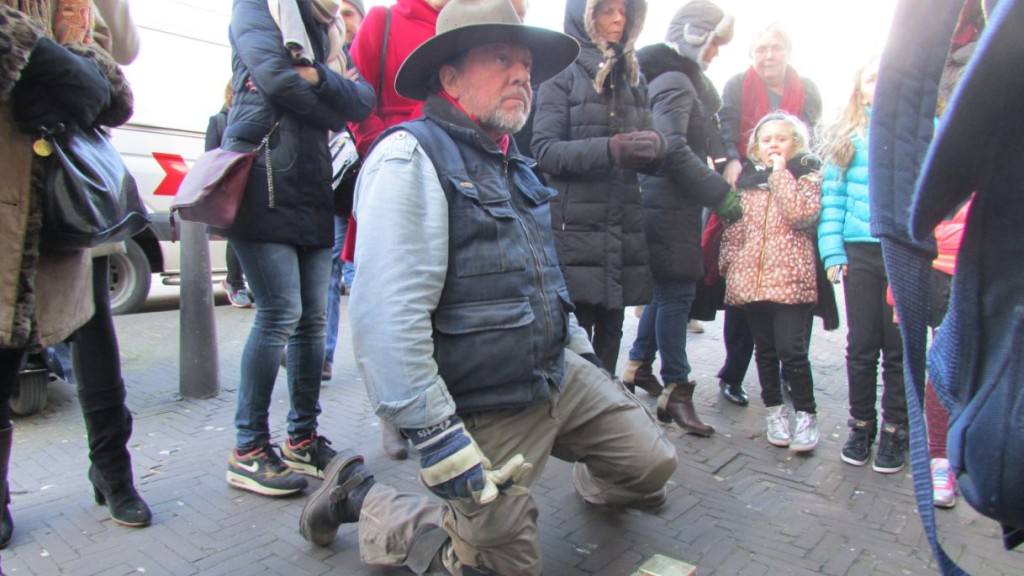
Since the early 1990s, artist Gunter Demnig has dedicated his professional career to placing memorial tripping stones in front of thousands of European homes. Photo Credit: Steven Klein
He insisted on putting away all of his equipment before he would allow one of Salomon and Fijtje’s grandchildren, Mart Cohen, to thank him, which seemed to make him shy. But once he had completed his work, he was ready to move on to the next destination.
Only by taking him aside for a few moments and talking to him could I discover his feelings about the event. For Demnig, the experience is no less powerful after more than 55,000 tripping stones than after the first.
“It will never become routine because such a meeting is incredible,” he explained inside his van. “Just this day today I was in two communities with young people. They are very interested to know about how [the Holocaust] could happen.”
Demnig sees his project as making the Holocaust more tangible for young people.
“It’s another form of history. They open a book, they read they murdered 6 million, maybe 6 to 9 million more for other reasons. That’s abstract, really abstract,” he says. “But then they have such a meeting and see the stones in front of the street. When there are young people, they count.
They think, ‘They are as old as me and they were murdered.’ It’s very deep expression.”
Just as the children of the Holocaust are getting older, so is Demnig, the artist. But, he has no intention for his project to die with him. A year ago he established a foundation, so that if “something happens to me, it will continue.”
A sense of closure
If Demnig looked more busy than emotional, one could forgive him after learning that our ceremony was the 11th of 12 destinations in three communities for him that day. A look at his website reveals a dizzying schedule. Demnig’s encounters with the families, usually about 15-20 minutes, do not allow him to see the full impact of his work.
In our case, the ceremony drew 30 relatives from the Netherlands, France and Israel. At first, Mart and his two first cousins, Joop de Graaf and Ruth Stranders, thought they would be the only ones to witness the laying of the tripping stone, known as struikelsteen in Dutch. However, as soon as their children heard about it, they wanted to bring their families, too.
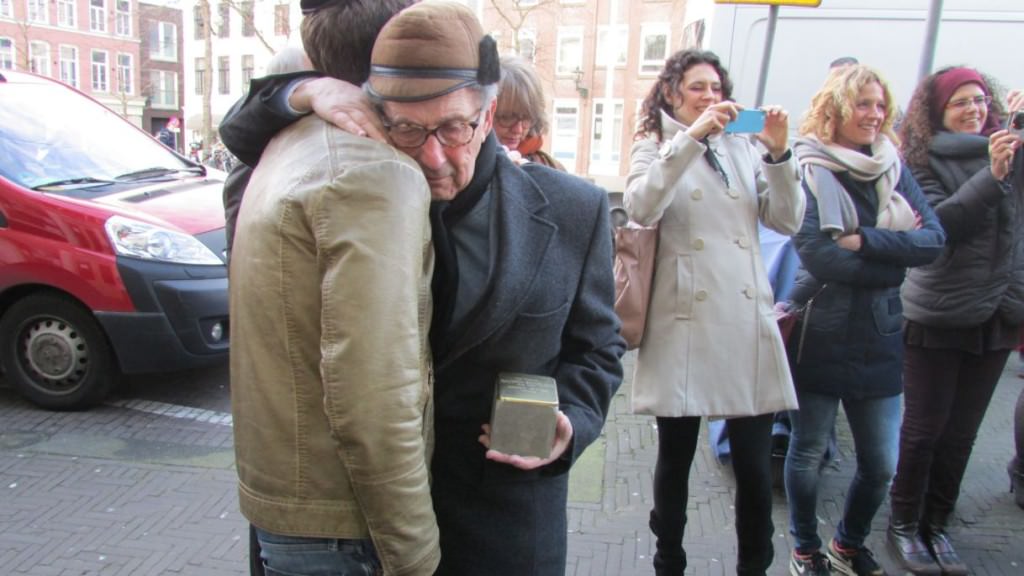
Mart Cohen, the grandson of Salomon and Fijtje, who initiated the process, hugging his grandson David Francois. Photo Credit: Steven J. Klein
They rented a cafe around the corner for the two to three hours preceding the ceremony for a family reunion. A separate ceremony evolved allowing various members to contribute to the commemoration. Mart and Joop made emotional speeches, with Mart recounting the names of all of Salomon and Fijtje’s descendants.
“They get no cemetery stone, but they get a memorial stone in front of the home where they lived,” observed Mart.
One great-grandchild, Ariel, played a pair of Naomi Shemer songs on the violin while another, Nili, read a poem. Joop read the Dutch version of a Yizkor prayer he composed in memory of his grandparents. Rivka Klein, my wife, pointed out that women are often left out of history, and so she had painted a picture of Fijtje based on her wedding photo, “Fijtje in Color.”
Lost to the Holocaust, there were almost no stories about Salomon and Fijtje. So I provided a family tree, a timeline, vital records and newspaper clippings about Salomon’s jewelry and precious-metal business that I had tracked down on the Internet.
The encounter moved all their descendants, Jewish and non-Jewish, some to tears. Ultimately, the experience brought us closer together, and the beauty was that although it was a Holocaust-related ceremony, the fact that we all bore witness together made it life-affirming.
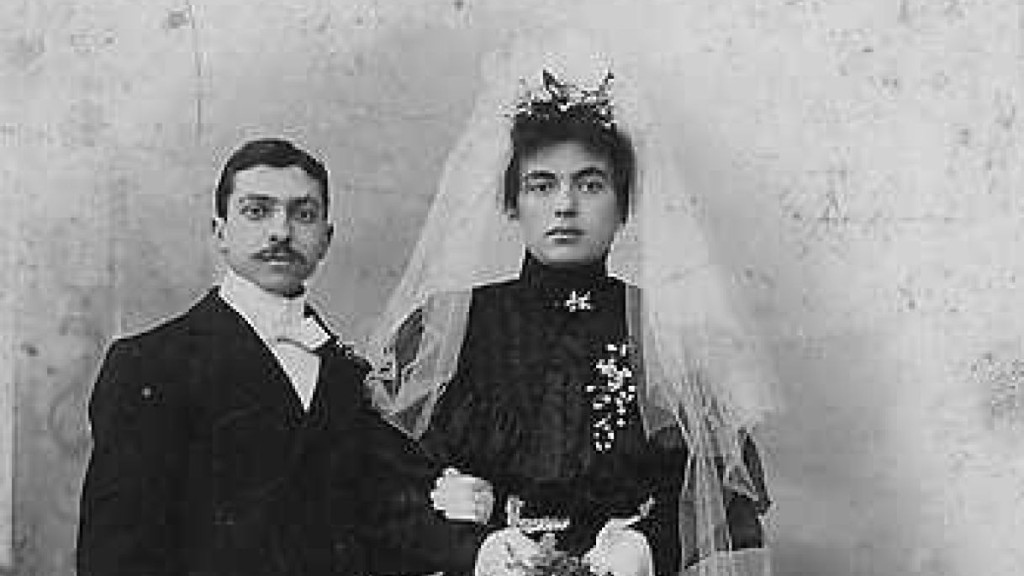
Salomon van Gelder and Fijtje Fruitman on their wedding day, November 23, 1904 in Leiden, The Netherlands. Photo Credit: Steven J. Klein
We also had the privilege of seeing the immediate impact of the stones on non-relatives. Coincidentally, the building’s store is once again a jewelry business. We met the store owner, a Baptist from Iraq who took it over five years ago, when it had been a snack shop.
He had been given two weeks’ notice about the ceremony by Mart, and was thrilled to learn that Salomon had also been a jeweler. When we went in after the ceremony, we gave him copies of some of the newspaper articles and a photograph of the street with the store from the 1930s, in which one could see the original shop sign.
“I want one just like that,” he told us. “And if City Hall won’t let me, I’ll just show them this!” He has since hung up the articles and photo in his shop.
There was a sense of closure in knowing that a refugee from the Middle East now occupies the place from which a Jewish family, some of whose descendants have since emigrated to the Middle East, was expelled.
Not all are comfortable with the ceremony, particularly with the idea that the ancestors’ names are on the ground, stepped on or stepped over by passers-by. My wife’s art teacher provided an elegant solution to that dilemma, conjecturing that when people step on the stones, the names of the victims pass through their feet and their bodies, and are thus carried out into the world.
Another surprising path to a tripping stone
One such person who does not buy into that image is Henry Foner, a Holocaust survivor who was one of the children on the Kindertransport to Great Britain. Henry, born in 1932, was one of eight family members forced to leave their Berlin home located on Kantstrasse.
“I had mixed feelings for a long time before about stepping on people’s names,” he told Haaretz this month. “In Amsterdam there are houses where on the wall they put a brass plaque that seemed to me a much preferable thing.”
The path leading him to a stolperstein ceremony was no less surprising than the unique relationship it produced.
In 2013, Yad Vashem published his Kindertransport memoir “Postcards to a Little Boy.” An interview with the Berliner Zeitung newspaper drew the notice of a woman working for the stolperstein organization in Berlin. She offered to pay for three of the stones, and Foner agreed to pay for the other eight.
He might not have attended the ceremony had it not been for another coincidence. Yad Vashem contacted Foner and told him that a woman in Hamburg who had read about his story in an article wanted to contact him. He agreed, he recalled, and she made him an offer in a letter that took him aback.
“She was not in any way personally responsible,” he stressed. “She said she felt German culture was responsible and asked if I would allow her to buy a stolperstein for my father without knowing I’d already been in touch with the organization.”
“I thought that was quite something,” he said. “It really touched me, so I wrote to her and said I’d be honored if you could pay the organization.” When it came time to lay the stone, the woman said she wanted to attend the ceremony.
“It’s 350 kilometers. I thought if she’s going to go, I’d like to meet this person,” he recalled. “Then it blossomed. My girls came and we went a day early meet this lady and we have become firm friends. It opened up a whole new vista for me that I have a pen friend in Germany.”
Originally published HERE.
